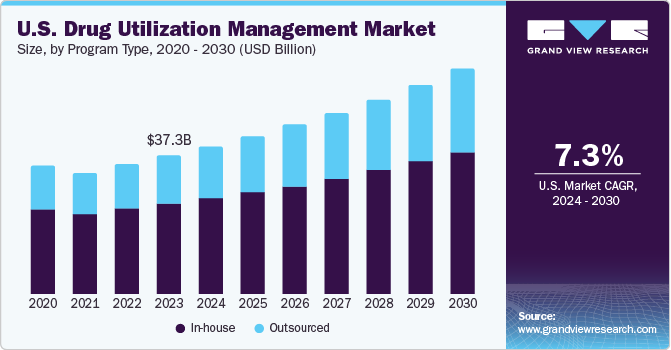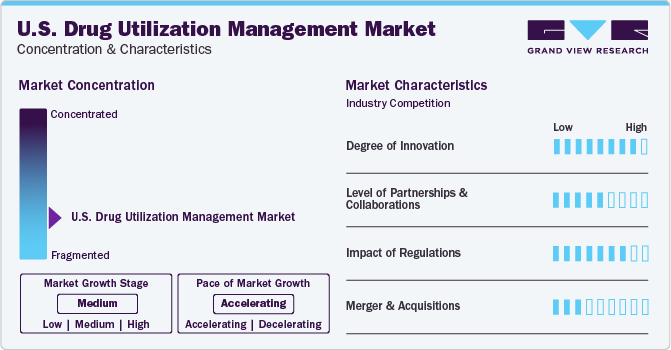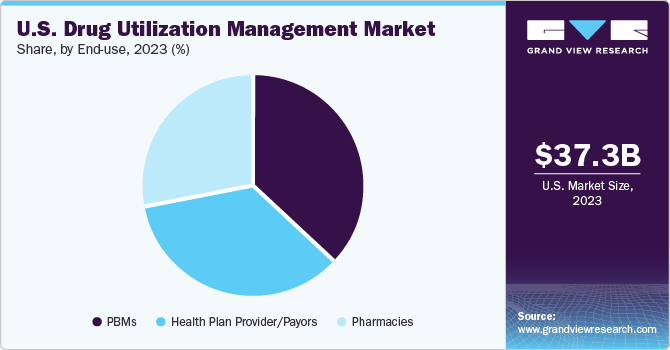- Home
- »
- Healthcare IT
- »
-
U.S. Drug Utilization Management Market, Report, 2030GVR Report cover
![U.S. Drug Utilization Management Market Size, Share & Trends Report]()
U.S. Drug Utilization Management Market Size, Share & Trends Analysis Report By Program Type (In-House, Outsourced), By End-use (PBMs, Health Plan Providers/Payors, Pharmacies), And Segment Forecasts, 2024 - 2030
- Report ID: GVR-4-68040-296-3
- Number of Report Pages: 140
- Format: PDF, Horizon Databook
- Historical Range: 2018 - 2023
- Forecast Period: 2024 - 2030
- Industry: Healthcare
Market Size & Trends
The U.S. drug utilization management market size was estimated at USD 37.25 billion in 2023 and is anticipated to grow at a CAGR of 7.30% from 2024 to 2030. Increasing use of automated utilization management services and the rising need for improved prescription patterns for specialty drugs to lower the overall cost & improve patient outcomes is expected to drive market growth over the forecast period.

Drug utilization management criteria, such as Prior Authorizations (PAs), step therapy, and quantity limits, are designed to optimize patient outcomes and reduce waste, errors, unnecessary drug use, & costs. These programs are essential for controlling healthcare costs, influencing patient care decisions, and improving the quality of treatment. Collaboration between prescribers, payers, and pharmacists has become more emphasized to ensure patients receive timely access to drugs while maintaining cost-effectiveness and value. The future of utilization management involves a growing reliance on pharmacists in the PA process, the adoption of Electronic PA (ePA) to streamline approvals, and the development of best practices & national standards for electronic health information exchange.
The need for cost containment in healthcare is further emphasized by the fact that the U.S. spends a substantial portion of its GDP on healthcare, with prescription drugs being a major source of this expenditure. According to the U.S. Centers for Medicare & Medicaid Services (CMS), in 2022, the U.S. spent USD 4.5 trillion on healthcare services, and around USD 772.5 billion was spent on prescription drugs in 2023, which is a 13.5% increase from 2022. To manage these costs effectively, healthcare providers and payers are implementing various strategies, including UM, which involves the use of clinical guidelines, formularies, and other tools to ensure that patients receive the most appropriate & cost-effective treatments. This approach not only helps reduce healthcare costs but also improves patient outcomes by ensuring that patients receive the best possible care.
Automated Utilization Management (UM) systems are experiencing increased demand in the U.S., particularly in pharmacy utilization management. These systems play a crucial role in evaluating the appropriateness, medical necessity, and efficiency of healthcare services provided to patients. The demand for automation in UM is fueled by the need to improve the quality of service at the right cost without sacrificing delivery and reimbursement systems with administrative burdens. Automated UM software like PAHub, RxMTM+, and FormularyHub by Agadia provide features to streamline authorization workflows, increase staff productivity, and improve compliance with regulatory requirements. This helps healthcare organizations cut costs, reduce turnaround times, and enhance the quality of care.
Market Concentration & Characteristics
The chart illustrates the relationship between the degree of market concentration and various market characteristics. The market has intense competition, the degree of innovation is high, and partnership and collaboration activity are common as firms seek to grow their market share. Regulators also tend to analyze concentrated markets more closely. M&A activity is moderate in these markets.

The degree of innovation in the market is significant, with a focus on technological advancements and emerging trends. Continuous technological innovations in drug management systems enhance the efficiency and effectiveness of in-house programs, making them attractive to healthcare organizations.
The partnership and collaboration in the market are primarily driven by companies focused on innovation in services, and geographical expansion. For instance, in September 2021, Point32Health, the not-for-profit parent company of Tufts Health Plan and Harvard Pilgrim Health Care, signed a multiyear partnership with Optum Rx. to provide integrated PBM solutions. This agreement was expected to improve services and pricing for Harvard Pilgrim & Tufts Health Plan members.
Regulatory and privacy issues have a significant impact on drug UM in the U.S. Regulatory burden, including state laws and federal regulations, influences the market trends. Each state in the U.S. has its own laws and regulations regarding PBMs and pharmacy utilization management. These laws address issues such as transparency in rebates, spread pricing, and fees, which are critical components of drug UM.
Major players are focusing on expanding their service portfolios, enhancing their technological capabilities, and pursuing strategic mergers & acquisitions to strengthen their market position. For instance, in April 2022, Change Healthcare and Optum extended their merger agreement and acquired Optum. This acquisition aimed to simplify and connect the core clinical, payment, and administrative processes healthcare providers and payers depend on to serve patients, resulting in lower costs and a better experience for all stakeholders.
Program Type Insights
Based on program type, the in-house segment dominated the market with the largest revenue share of 65.10% in 2023. It is due to the cost savings, utilization management, and administrative efficiencies it provides to health plans & employers. This trend is due to the healthcare industry's move towards vertical integration. Pharmacy Benefit Managers (PBMs) implement utilization management strategies such as prior authorization and step therapy to promote appropriate medication use.
Moreover, high utilization of prescription drugs in the U.S. necessitates efficient in-house programs for handling prescription amounts filled by retail pharmacies. Some of the in-house providers of drug/pharmacy utilization management include Ultimate Health Plans, Security Health Plan of Wisconsin, Inc., and Blue Cross Blue Shield Association.
However, the outsourced segment is expected to witness the fastest growth over the forecast period. The demand for outsourced programs in the U.S. market is primarily driven by the need for healthcare providers to focus on delivering high-quality care while ensuring efficient UM services. This approach ensures that patients receive optimal care while controlling healthcare expenses. These factors are expected to drive the segment’s growth during the forecast period.
End-use Insights
Based on end-use, the PBMs segment dominated the market in 2023 with a share of 37.19% and is expected to have the fastest growth rate during the forecast period. PBMs are effective at negotiating discounted drug prices and refunds from pharmaceutical manufacturers. By managing drug formularies and utilization, PBMs help control medication costs for health insurance plans and employers. PBMs simplify operations by managing administrative tasks like pharmacy network management, claims processing, and benefit plan design, reducing the workload for insurers, employers, & pharmacies.

The health plan provider/payors segment is expected to witness substantial growth over the forecast period. With the growing healthcare spending in the U.S., stakeholders are continuously working to address the drivers of high costs. The overuse of healthcare services, which includes treatments with little or no benefits, not only negatively impacts the physical and mental well-being of patients but also results in increased healthcare expenses. Health plan providers leverage drug utilization management strategies to help decrease unnecessary services and ensure patients receive appropriate, quality, and cost-effective care. This leads to an increase in the growth of the segment during the forecast period.
Key U.S. Drug Utilization Management Company Insights
The market is highly competitive, with the presence of major players such as Optum, Inc.; Prime Therapeutics LLC.; and MedicusRx. Many notable health insurers have acquired or partnered with PBM companies, creating vertically integrated healthcare organizations. While the market is dominated by a few large players, there are emerging competitors, such as nonprofit partnerships, creating new PBMs to offer services for employers.
Key U.S. Drug Utilization Management Companies:
Third Party Providers:
- Prime Therapeutics LLC
- MedicusRx
- EmblemHealth
- Optum, Inc.
- Point32Health, Inc.
- AssureCare LLC
- MindRx Group
- Agadia Systems, Inc
- Elevance Health (CarelonRx)
- ExlService Holdings, Inc.
- MRIoA
- S&C Technologies, Inc.
In-House Providers:
- Ultimate Health Plans
- Security Health Plan of Wisconsin, Inc.
- Blue Cross and Blue Shield Association
- Providence
- Simply Healthcare Plans, Inc
- Health Plan of San Mateo (HPSM)
- PerformRx
- Aetna, Inc. (CVS Health Corp.)
Recent Developments
-
In March 2024, Capital Rx and Prime Therapeutics, a major pharmacy solutions organization, entered a strategic alliance. As part of this alliance, Prime Therapeutics would have exclusive access to Capital Rx’s advanced JUDI enterprise health platform. JUDI is a cloud-native platform that unifies all PBM operations into one system.
-
In September 2021, Point32Health, the not-for-profit parent company of Tufts Health Plan and Harvard Pilgrim Health Care, signed a multiyear partnership with Optum Rx. to provide integrated PBM solutions. This agreement was expected to improve services and pricing for Harvard Pilgrim & Tufts Health Plan members
U.S. Drug Utilization Management Market Report Scope
Report Attribute
Details
Market size value in 2024
USD 39.77 billion
Revenue forecast in 2030
USD 60.68 billion
Growth Rate
CAGR of 7.30% from 2024 to 2030
Actual data
2018 - 2023
Forecast period
2024 - 2030
Quantitative units
Revenue in USD million/billion and CAGR from 2024 to 2030
Report coverage
Revenue forecast, company ranking, competitive landscape, growth factors, and trends
Segments covered
Program type, end-use
Key companies profiled
Prime Therapeutics LLC; MedicusRx; EmblemHealth; Optum, Inc.; Point32Health, Inc.; AssureCare LLC; MindRx Group; Agadia Systems, Inc; Elevance Health (CarelonRx); ExlService Holdings, Inc.; MRIoA; S&C Technologies, Inc.; Ultimate Health Plans; Security Health Plan of Wisconsin, Inc.; Blue Cross and Blue Shield Association; Providence; Simply Healthcare Plans, Inc; Health Plan of San Mateo (HPSM); PerformRx; Aetna, Inc. (CVS Health Corp.)
Customization scope
Free report customization (equivalent up to 8 analysts working days) with purchase. Addition or alteration to country, regional & segment scope.
Pricing and purchase options
Avail customized purchase options to meet your exact research needs. Explore purchase options
U.S. Drug Utilization Management Market Report Segmentation
This report forecasts revenue growth at country levels and provides an analysis on the latest industry trends and opportunities in each of the sub-segments from 2018 to 2030. For this study, Grand View Research has segmented the U.S. drug utilization management market report based on program type and end-use:
-
Program Type Outlook (Revenue, USD Billion, 2018 - 2030)
-
In-house
-
Outsourced
-
-
End-use Outlook (Revenue, USD Billion, 2018 - 2030)
-
PBMs
-
Health Plan Provider/Payors
-
Pharmacies
-
Share this report with your colleague or friend.
![gvr icn]()
NEED A CUSTOM REPORT?
We can customize every report - free of charge - including purchasing stand-alone sections or country-level reports, as well as offer affordable discounts for start-ups & universities. Contact us now
![Certified Icon]()
We are GDPR and CCPA compliant! Your transaction & personal information is safe and secure. For more details, please read our privacy policy.
We are committed towards customer satisfaction, and quality service.
"The quality of research they have done for us has been excellent."





